TANAGRINA
MOSTRA PERMANENTE
Casa Museo Ivan Bruschi
TANAGRINA
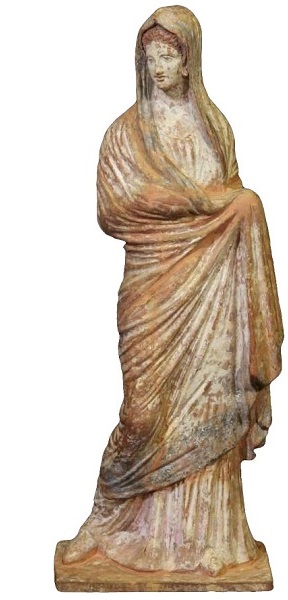
Translation by
Maddison Freeman, OU University
Statue in Terracotta Painting
Woman Figure
GREECE, LATE IV-BEGINNING III SEC. B.C.
- The term “tanagrina” derives from the name of the ancient Greek city of Tanagra, in Boeotia, where there have been finds of ceramic funerary items including the famous clay statuettes of expressiveness, precisely called “tanagrine”. The sculptures could represent female figures caught in various attitudes, but also children and grotesque figures. The term “tanagrine” was later adopted to define similar clay statuettes found in other places such as Centuripe and other areas of Magna Graecia.
Find the glossary at the bottom of the page.
Restored in 2020 by the Opificio delle Pietre Dure in Florence.
ANALYSIS OF THE EXECUTIVE TECHNIQUE
- The clay statuette is made in the round using the cast technique.
- Inside, numerous fingerprints are visible.
- The thickness of the statuette is very thin, ranging from 5 mm to 2 mm.
- The cast molding allows a series processing, with the advantage of a greater speed of execution and uniformity of results.
- The work is polychrome; there are traces of color in the face, in the chiton, and in the himàtion.
THE CALCO MODELING
- Figure 1- REALIZATION OF A FIRST ORIGINAL MODEL
- Generally small in size
- Strong material (probably terracotta)
- Free of strong undercuts
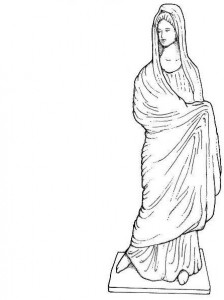
- Figure 2- REALIZATION OF THE TEMPLATE
- Generally made of clay, although plaster templates were already known in ancient times
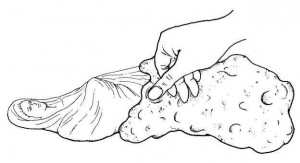
- Figure 3- OBTAINING THE TEMPLATE
- Two meeting sections, thanks to the absence of strong undercuts
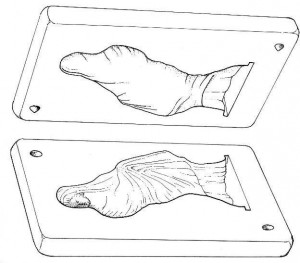
- Figure 4- REALIZATION OF THE STATUETTE
- Application of clay powder as a release agent
- Pressure of clay sheets inside the template
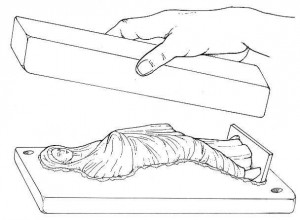
- Figure 5- OBTAINING THE STATUETTE
- Extraction of the positive form from the template
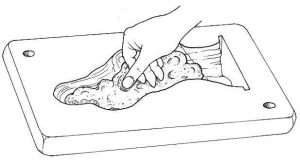
- Figure 6- FINISHING
- Elimination of burrs
- Adding hand-modeled parts
- Retouching
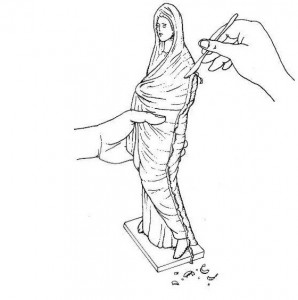
PROCESSING TRACES
- Figure 1
- Marks left by the cue
- Figure 2
- Fingerprints
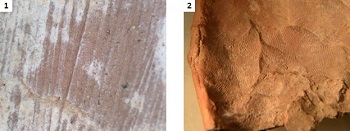
TRACES OF POLYCHROMES
- Pink on the chiton, blue and white in the himàtion, white on the face, and brown on the hair.
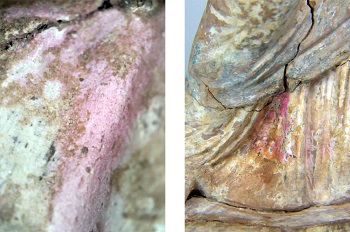
- BEFORE / AFTER
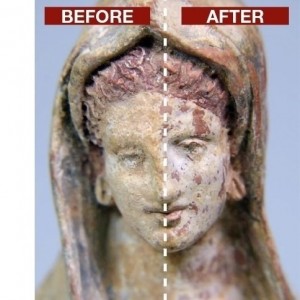
Glossary
- Terracotta Painting: the terracotta has traces of paint.
- Cloaked figure: wrapped, covered with a mantle
- Clay statue: which is molded of terracotta.
- Chiton: dress of East origin introduced in Greece by the Ionians, made with a cloth of light fabric (generally linen or light wool) sewn like a sack without a bottom, tied at the waist by a cord and fastened at the shoulder with two buttons, short for men, long for high-ranking characters and women.
- Himàtion: a kind of cloak that the ancient Greeks often wore over the chiton. It consisted of a rectangle, mostly of wool, which was draped in various ways generally throwing it over the left shoulder. In the female version, it enveloped the whole body, including the head.
- Sottosquadri: is the technique of carving and sculpture, especially in bas-relief, the name of the deeper grooves that form an acute angle with the plane constituted by the bottom of the work: cutting, sculpting a figure to the left, or below – by a square angle.
- Splint: elongated rod of different shape and material depending on use and destination.

